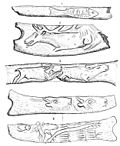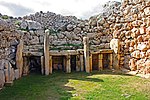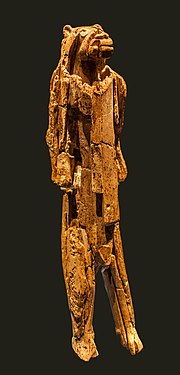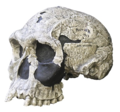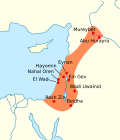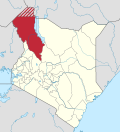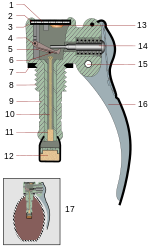Lomekwi is an archaeological site located on the west bank of Turkana Lake in Kenya. It is an important milestone in the history of human archaeology...
11 KB (1,118 words) - 00:34, 15 May 2024
Kenyanthropus is a genus of extinct hominin identified from the Lomekwi site by Lake Turkana, Kenya, dated to 3.3 to 3.2 million years ago during the...
26 KB (3,375 words) - 09:29, 2 November 2024
prehistory and history, from the development of the first stone tools at Lomekwi in East Africa 3.3 million years ago up until recent decades. Archaeology...
135 KB (13,985 words) - 03:54, 2 November 2024
However, even older tools were later discovered at the single site of Lomekwi 3 in Kenya, in 2015, dated to as early as 3.3 million years ago. As such...
15 KB (1,790 words) - 23:05, 10 June 2024
the earliest stone tools dated to around 3.3 million years ago at the Lomekwi site in Kenya. These tools predate the genus Homo and were probably used...
56 KB (5,895 words) - 17:42, 3 November 2024
tool-users known. The oldest stone tools were excavated from the site of Lomekwi 3 in West Turkana, northwestern Kenya, and date to 3.3 million years old...
80 KB (10,300 words) - 05:38, 10 November 2024
Sonia Harmand (section Lomekwi 3 stone tools)
place. In 2011, Harmand discovered the Lomekwi 3 stone tools in the Turkana Basin of Kenya near the town of Lomekwi. This discovery was made while Harmand...
9 KB (993 words) - 05:23, 1 June 2024
chronological order. Kenya Stone tools found from 2011 to 2014 at the Lomekwi archeology site near Lake Turkana in Kenya, are dated to be 3.3 million...
35 KB (3,989 words) - 23:09, 3 November 2024
Paleolithic ↑ Pliocene (before Homo) Lower Paleolithic (c. 3.3 Ma – 300 ka) Lomekwi (3.3 Ma) Oldowan (2.6–1.7 Ma) Acheulean (1.76–0.13 Ma) Madrasian (1.5 Ma)...
107 KB (11,383 words) - 14:54, 29 September 2024
Brenet, Michel (May 20, 2015). "3.3-million-year-old stone tools from Lomekwi 3, West Turkana, Kenya". Nature. 521 (7552): 310–315. Bibcode:2015Natur...
263 KB (26,340 words) - 01:38, 6 November 2024
manipulative hands. Males grew very large, as evidenced by a specimen found at Lomekwi, Kenya, which was estimated to have weighed approximately 43.8 kilograms...
3 KB (290 words) - 20:14, 8 September 2024
periodization. This date comes from the 2015 discovery of stone tools at the Lomekwi site in Kenya. Some paleontologists propose an earlier date of 3.39 million...
267 KB (27,560 words) - 08:32, 5 November 2024
Paleolithic ↑ Pliocene (before Homo) Lower Paleolithic (c. 3.3 Ma – 300 ka) Lomekwi (3.3 Ma) Oldowan (2.6–1.7 Ma) Acheulean (1.76–0.13 Ma) Madrasian (1.5 Ma)...
45 KB (4,699 words) - 14:36, 10 November 2024
fossilisation process), the attribution to butchery is dubious. In 2015, the Lomekwi culture was discovered at Lake Turkana dating to 3.3 mya, possibly attributable...
48 KB (5,126 words) - 12:00, 4 October 2024
Dennis V.; Roche, Hélène (2015). "3.3-million-year-old stone tools from Lomekwi 3, West Turkana, Kenya". Nature. 521 (7552): 310–15. Bibcode:2015Natur...
88 KB (3,574 words) - 02:31, 27 October 2024
Australopithecines are also known to have manufactured tools, such as the 3.3 Ma Lomekwi stone tool industry, and some evidence of butchering from about 3.4 mya...
51 KB (6,232 words) - 05:23, 27 October 2024
stone. The earliest stone tools to date have been found at the site of Lomekwi 3 (LOM3) in Kenya and they have been dated to around 3.3 million years...
9 KB (1,177 words) - 15:09, 23 October 2024
anthropologist Fred Spoor suggests it may have been involved in the Kenyan Lomekwi stone-tool industry typically assigned to Kenyanthropus. A. deyiremeda...
13 KB (1,479 words) - 04:34, 23 May 2024
simpler australopithecine stone traditions (the only one identified is the Lomekwi industry). In either case, the transition to sharper tools would have allowed...
7 KB (804 words) - 04:27, 22 July 2024
Paleolithic ↑ Pliocene (before Homo) Lower Paleolithic (c. 3.3 Ma – 300 ka) Lomekwi (3.3 Ma) Oldowan (2.6–1.7 Ma) Acheulean (1.76–0.13 Ma) Madrasian (1.5 Ma)...
62 KB (6,794 words) - 01:40, 4 November 2024
dating to 3.4 mya attributed to A. afarensis, and the 2015 discovery of the Lomekwi culture from Lake Turkana dating to 3.3 mya possibly attributed to Kenyanthropus...
17 KB (2,043 words) - 01:52, 14 November 2023
Stone Age industries in prehistory were found in Turkana, at the site of Lomekwi, and date to 3,300,000 years. At the archaeological site of Nataruk, in...
21 KB (1,793 words) - 18:23, 1 November 2024
the Paleolithic Period. The earliest stone tools are from the site of Lomekwi, Turkana, dating from 3.3 million years ago. Stone tools diversified through...
33 KB (4,111 words) - 19:44, 15 October 2024
Paleolithic ↑ Pliocene (before Homo) Lower Paleolithic (c. 3.3 Ma – 300 ka) Lomekwi (3.3 Ma) Oldowan (2.6–1.7 Ma) Acheulean (1.76–0.13 Ma) Madrasian (1.5 Ma)...
43 KB (4,853 words) - 17:37, 23 October 2024
stone tools that predate the Oldowan, dated to as early as 3.3 Ma, at the Lomekwi site in Kenya, was announced in 2015. This age pre-dates the current estimates...
64 KB (7,432 words) - 01:22, 31 October 2024
Paleolithic ↑ Pliocene (before Homo) Lower Paleolithic (c. 3.3 Ma – 300 ka) Lomekwi (3.3 Ma) Oldowan (2.6–1.7 Ma) Acheulean (1.76–0.13 Ma) Madrasian (1.5 Ma)...
10 KB (1,022 words) - 16:37, 19 October 2024
reported in 2003. An ostensible industry dating to 3.3 million years ago, the Lomekwi, was proposed in 2015. Schamlzer 2008, p. 85–87. Black, D. 1927: "On a...
92 KB (10,979 words) - 08:44, 16 October 2024
Paleolithic ↑ Pliocene (before Homo) Lower Paleolithic (c. 3.3 Ma – 300 ka) Lomekwi (3.3 Ma) Oldowan (2.6–1.7 Ma) Acheulean (1.76–0.13 Ma) Madrasian (1.5 Ma)...
20 KB (1,704 words) - 21:46, 31 May 2024
Paleolithic ↑ Pliocene (before Homo) Lower Paleolithic (c. 3.3 Ma – 300 ka) Lomekwi (3.3 Ma) Oldowan (2.6–1.7 Ma) Acheulean (1.76–0.13 Ma) Madrasian (1.5 Ma)...
18 KB (1,795 words) - 06:32, 12 September 2024
Paleolithic ↑ Pliocene (before Homo) Lower Paleolithic (c. 3.3 Ma – 300 ka) Lomekwi (3.3 Ma) Oldowan (2.6–1.7 Ma) Acheulean (1.76–0.13 Ma) Madrasian (1.5 Ma)...
15 KB (1,468 words) - 14:38, 1 September 2024





